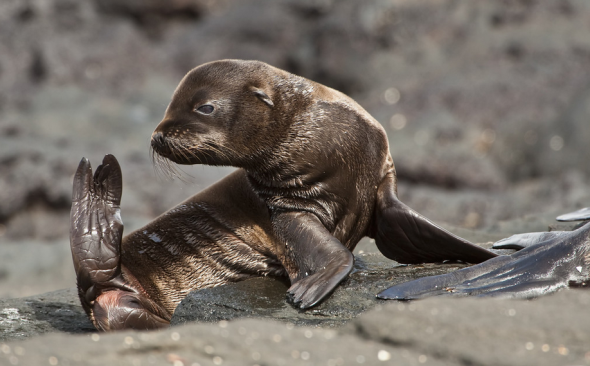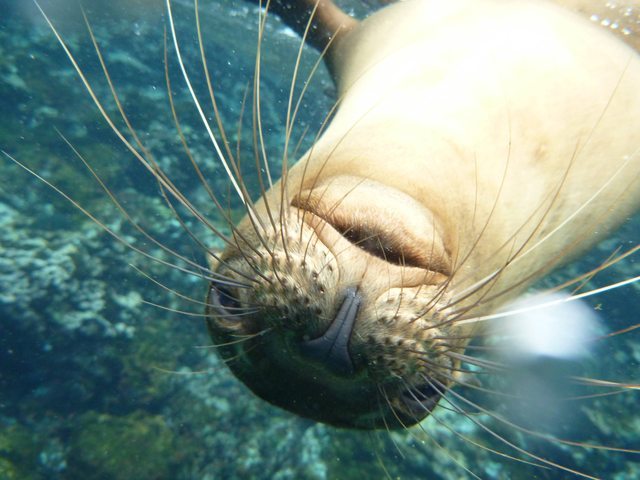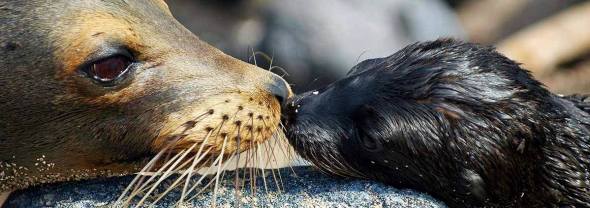Endangered Species Friday - Arctocephalus galapagoensis
Endangered Species Friday - Arctocephalus galapagoensis
This Fridays endangered species article we take a brief look into the life of the Galapagos Fur Seal, scientifically identified as Arctocephalus galapagoensis, and identified back in 1904 by marine biologist Dr Heller. Listed as endangered the species is endemic to Ecuador, and the Pacific South East. Pictured above is one of many declining colonies of the Galapagos Fur Seal Pups (credited to Stephanie Brand) from Arizona, United States.
Back in 1982 the species was officially declared “out of danger” however from 2010 reports soon came flocking in that the Galapagos Fur Seal was again listing back into its old threatened status. From 1996 evaluations of the species saw A. galapagoensis relisted as (vulnerable).
Further opinionated evaluations by marine biologists Baillie and Groombridge confirmed the species was sadly nearing the realms of endangerment (1996). Census’s of A. galapagoensis (2010) have unfortunately relisted the species as now (endangered). A final evaluation of species populations now confirms populations are declining, very rapidly.
Back in 1978 environmentalists conducted a marine census of the species that placed the population size at some 30,000 to 40,000 individuals. El Niño which is the warm phase of the El Niño Southern Oscillation (commonly called ENSO) and is associated with a band of warm ocean water that develops in the central and east-central equatorial Pacific (between approximately the International Date Line and 120°W), including off the Pacific coast of South America, has been blamed for high mortality rates of seal pups.
Image: Galapagos Fur Seal
Population sizes have been said to be (fluctuating) since the last in-depth populastion report on the species back in the mid to late nineteen seventies. Recovery since this time is currently unknown, however reports from 2010 can be viewed here that do provide further although little information on recovery at least. Surveys undertaken since the last 2010 report now place the number of A. galapagoensis at a depressing 10,000 to 15,000 individuals. That’s quite a significantly large decline since the species last census count, and on discovery of which population sizes were over 70,000-90,000 individuals 1904-1908-(census).
Galápagos Fur Seals live in large colonies on the rocky shores. These colonies are then divided into territories by the female seals during breeding season, which is mid-August to mid-November. Every mother seal claims a territory for herself and breeds her pup there. Galápagos Fur Seals have the lowest reproductive rate reported in seals, and it takes an unusually long time to raise seal pups to independence.
Females bear only one pup at a time, and she remains with her newborn for a week before leaving to feed. She then periodically returns to the pup and stays to suckle it for a few days before leaving on another hunting trip. Females recognize their own pups by smell and sound, and pups also learn to identify their mothers by the females’ “Pup Attraction Calls”.
Mother-pup recognition is crucial because females exclusively nurse their own pups, often violently rejecting strange pups that approach. Orphaned seal pups usually try to sneak up on sleeping or calling females to suckle, but stealing milk is not enough to sustain the pups, and they usually die within a month.
The Galápagos Fur Seal feeds primarily on fish and cephalopods. They feed relatively close to shore and near the surface, but have been seen at depths of 169 m (554 ft). They primarily feed at night because their prey is much easier to catch then. During normal years, food is relatively plentiful. However, during an El Niño year, there can be fierce competition for food, and many young pups die during these years. The adult seals feed themselves before their young and during particularly rough El Niño years, most of the young seal populations will die.
The Galápagos Fur Seal has virtually no constant predators. Occasionally, sharks and orcas have been seen feeding on the seals, but this is very rare. Sharks and orcas are the main predator of most other seal species, but their migration paths do not usually pass the Galápagos.
Image: Galapagos Fur Seal and Cub
Threats
Similar to all southern fur seals there was a severe population decline as a result of 19th century exploitation by sealers and whalers. The species was near extinction early in the 20th century and has since recovered (although as explained species populations are declining and the Galapagos Fur Seal species are listed as endangered).
El Niño events dramatically elevate mortality rates of all age classes and cause population declines; this is due to the dramatic declines in productivity around the Archipelago during these events. Tourism in the Galápagos, which is an Ecuadorian National Park, is heavy but regulated, and fur seals are protected.
Episodes of entanglement in local net fisheries have been reported and are thought to be increasing over the last years. Feral dogs on Isabela Island which killed fur seals of all ages have been exterminated. This problem could erupt again if other feral dogs find their way to colony sites.
The most serious threat at present is transmission of diseases from dogs to pinnipeds. Like all fur seals, Galápagos Fur Seals are vulnerable to oil spills because of their dependence on their thick pelage for thermoregulation. Although there is limited large vessel traffic in the Galápagos Archipelago, numerous small and medium sized vessels operate in the area that could release moderate quantities of oils, fuels, and lubricants if involved in a marine accident.
Galápagos Fur Seals have experienced declines from El Niño-caused ocean warming and associated reduced marine productivity (Trillmich and Dellinger 1991) estimated of up to 80%, but the exact extent of population reduction is not clear. Therefore, although the effects of global climate change on this species and its habitat are uncertain at this time, it is possible that any change related disruption of present day ocean currents, levels of marine productivity, or increased air temperatures at haul out sites would adversely affect this species.
Despite their population size, the Galápagos Fur Seal population will always be vulnerable to a variety of threats because of the species’ restricted distribution to a relatively small Archipelago of islands.
International Animal Rescue Foundation Brazil worked with these stunning animals for approximately a year and a half. The South American organisation has sadly stated that the species may soon be extinct within the next decade. Despite “any” protection measures that we or other throw at the species we have non-human and non-animal natural events that could wipe the entire species out in a single El Nino season.
Thank you for reading.
Chief Executive Officer/Chief Environmental Officer
Dr Jose C. Depre.
International Animal Rescue Foundation Africa - Asia.
info@international-animalrescue-foundation.org.uk
Chief Environmental Officer South America and Europe. (Head Registrar).
Dr J. Williamson EnVstu. PhD, Ba.
International Animal Rescue Foundation Europa - South America - United States
info@international-animalrescue-foundation.org.uk
Have you spotted a typo or error? Please email us above and we’ll work to rectify the problem as soon as possible.





